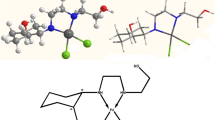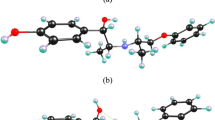Abstract
The Pd(DAP)Cl2 complex, where DAP is 2,6-diaminopyridine, was synthesized and characterized. The stoichiometries and stability constants of the complexes formed between various biologically relevant ligands (amino acids, amides, DNA constituents, and dicarboxylic acids) and [Pd(DAP)(H2O)2]2+ were investigated at 25 °C and at constant 0.1 mol·dm−3 ionic strength. The concentration distribution diagrams of the various species formed were evaluated. A further investigation of the binding properties of the diaqua complex [Pd(DAP)(H2O)2]2+ with calf thymus DNA (CT-DNA) was investigated by UV–Vis spectroscopy. The intrinsic binding constants (K b) calculated from UV–Vis absorption studies is 1.04 × 103 mol·dm−3. The calculated (K b) value was found to be of lower magnitude than that of the classical intercalator EB (ethidium bromide) (K b = 1.23 (±0.07) × 105 mol·dm−3), suggesting an electrostatic and/or groove binding mode for the interaction with CT-DNA.






Similar content being viewed by others
References
Rajendran, S.K., Sankaralingam, A.: DNA binding and antimicrobial studies of polymer–copper(II) complexes containing 1,10-phenanthroline and l-phenylalanine ligands. Eur. J. Med. Chem. 44, 1878–1883 (2009)
Kelland, L.R.: Overcoming the immortality of tumour cells by telomere and telomerase based cancer therapeutics—current status and future prospects. Eur. J. Cancer 41, 971–979 (2005)
Song, Y.M., Lu, X.-L., Yang, M.-L., Zheng, X.-R.: Study on the interaction of platinum(IV), gold(III) and silver(I) ions with DNA. Trans. Met. Chem. 30, 99–502 (2005)
Zhang, Q.-L., Liu, J.-G., Chao, H., Xue, G.-Q., Ji, L.-N.: DNA-binding and photocleavage studies of cobalt(III) mixed-polypyridyl complexes containing 2-(2-chloro-5-nitrophenyl)imidazo [4,5-f][1, 10]phenanthroline. J. Inorg. Biochem. 85(4), 291–296 (2001)
Chitrapriya, N., Mahalingam, V., Zeller, M., Natarajan, K.: Synthesis, characterization, crystal structures and DNA binding studies of nickel(II) hydrazone complexes. Inorg. Chim. Acta 363, 3685–3693 (2010)
Jackson, B.A., Alekseye, V.Y., Barton, J.K.: A versatile mismatch recognition agent: specific cleavage of a plasmid DNA at a single base mispair. Biochemistry 38, 4655–4662 (1999)
Zhang, Q.L., Ji, L.N., Cao, Y., Shi, X.: Synthesis, characterization and interaction of mixed polypyridyl ruthenium(II) complexes with calf thymus DNA. J. Coord. Chem. 26, 733–738 (1999)
Hall, D.B., Holmlin, R.E., Barton, J.K.: Oxidative DNA damage through long-range electron transfer. Nature 22(382), 731–735 (1996)
Jakupec, M.A., Galanski, M., Arion, V.B., Hartinger, C.G., Keppler, B.K.: Antitumour metal compounds: more than theme and variations. J. Chem. Soc., Dalton Trans. 2, 183–194 (2008)
Divsalar, A., Saboury, A.A., Yousefi, R., Moosavi-Movahedi, A.A., Mansoori-Torshizi, H.: Spectroscopic and cytotoxic studies of novel designed palladium complexes: beta lactoglobulin and K562 as targets. Int. J. Biol. Macromol. 40, 381–386 (2006)
Mohamed, M.S., Shoukry, A.A., Ali, A.G.: Synthesis and structural characterization of ternary Cu(II) complexes of glycine with 2,2-bipyridine and 2,2-dipyridylamine. The DNA-binding studies and biological activity. Spectrochim. Acta Part A 86, 562–570 (2012)
Raman, N., Raja, J.D., Sakthivel, A.: Synthesis, spectral characterization of Schiff base transition metal complexes: DNA cleavage and antimicrobial activity studies. J. Chem. Sci. 119, 303–310 (2007)
Swamy, S.J., Reddy, E.R., Raju, D.N., Jyothi, S.: Synthesis and spectral investigation of manganese(II), cobalt(II), nickel(II), copper(II) and zinc(II) complexes of new polydentate ligands containing a 1,8-naphthyridine moiety. Molecules 11, 1000–1008 (2006)
Yazicı, A., Akgün, F.: Synthesis and characterization of two new Schiff base ligands and their complexes with cobalt(II), nickel(II) and copper(II). Transit. Met. Chem. 31, 152–156 (2006)
Shoukry, A.A.: Complex formation reactions of promethazine copper(II) and various biologically relevant ligands. Synthesis, equilibrium constants, spectroscopic characterization and biological activity. J. Solution Chem. 40, 796–1818 (2011)
Shoukry, A.A., Hosney, W.M.: Coordination properties of N,O-carboxymethyl chitosan (NOCC). Synthesis and equilibrium studies of some metal ion complexes. Ternary complexes involving Cu(II) with (NOCC) and some biorelevant ligands. Cent. Eur. J. Chem. 10, 59–70 (2012)
Shoukry, A.A., Shoukry, M.M., Hafez, M.N.: Kinetics of base hydrolysis of α-amino acid esters catalyzed by palladium(II) piperazine complex. Cent. Eur. J. Chem. 8, 797–805 (2010)
Shoukry, M.M., Shoukry, A.A., Hafez, M.N.: Complex formation reactions between [Pd(piperazine)(H2O)2]2+ and biorelevant ligands: synthesis and equilibrium constants. J. Coord. Chem. 63, 652–664 (2010)
Shoukry, A.A., Brindell, M., van Eldik, R.: Kinetics and mechanism of the substitution behaviour of Pd(II) piperazine complexes with different biologically relevant nucleophiles. Dalton Trans. 37, 4169–4174 (2007)
Shoukry, A.A., Mohamed, M.M., Shoukry, M.M.: Binary and ternary complexes of copper(II) involving N,N,N,N-tetramethylethylenediamine (Me4en) and various biologically relevant ligands. J. Solution Chem. 35, 853–868 (2006)
Shoukry, A.A.: Complex formation reactions of (2,2-dipyridylamine) copper(II) with various biologically relevant ligands. The kinetics of hydrolysis of amino acid esters. Transit. Met. Chem. 30, 814–827 (2005)
Shoukry, A.A., Mohamed, M.S.: DNA-binding, spectroscopic and antimicrobial studies of palladium(II) complexes containing 2,2-bipyridine and 1-phenylpiperazine. Spectrochim. Acta Part A. 96, 586–593 (2012)
Ishow, E., Gourdon, A., Launay, J.P.: Observation of supramolecular π–π dimerization of a dinuclear ruthenium complex by 1H NMR and ESMS. Chem. Commun. 17, 1909–1910 (1998)
Gans, P., Sabatini, A., Vacca, A.: An improved computer program for the computation of formation constants from potentiometric data. Inorg. Chim. Acta 18, 237–239 (1976)
Pettit, L.D.: SPECIES, available program supplied to the authors. Academic Software, Old Farm (1993)
Shehata, M. R., Shoukry, M. M., Nasr, F. M., Van Eldik, R.: Complex-formation reactions of dicholoro(S methyl-l-cysteine)palladium(II) with bio-relevant ligands. Labilization induced by S-donor chelates. J. Chem. Soc., Dalton Trans., 779–786 (2008)
Mohamed, M.A., El-Sherif, A.A.: Complex formation equilibria between zinc(II), nitrilo-tris(methyl phosphonic acid) and some bio-relevant ligands. The kinetics and mechanism for zinc(II) ion promoted hydrolysis of glycine methyl ester. J. Solution Chem. 39, 639–653 (2010)
El-Qisairia, A.K., Qaseera, H.A., Zaghalb, M.H., Magairehb, S., Saymehb, R., Yousef, Y.A.: Synthesis, characterization and NMR studies of some 2,6-diaminopyridine complexes with palladium(II), rhodium(III) and mercury(II). Jordan J. Chem. 2, 255–264 (2007)
El-Sherif, A.A., Shoukry, M.M., van Eldik, R.: Complex-formation reactions and stability constants for mixed-ligand complexes of diaqua(2-picolylamine)palladium(II) with some bio-relevant ligands. J. Chem. Soc., Dalton Trans. 7, 1425–1432 (2013)
Shoukry, A., Rau, T., Shoukry, M.M., van Eldik, R.: Kinetics and mechanisms of the ligand substitution reactions of is(amine)(cyclobutane-1,1-dicarboxylato) palladium(II). J. Chem. Soc., Dalton Trans. 18, 3105–3112 (1998)
Shoukry, M.M., Shoukry, A.A., Khalafallah, P.A., Hassan, S.S.: Equilibrium and kinetic investigation of the interaction of model palladium(II) complex with biorelevant ligands. Int. J. Chem. Kinet. 42, 608–618 (2010)
Sigel, H., Massoud, S.S., Corfu, N.A.: Comparison of the extent of base back binding in complexes of divalent metal ions with guanine (GMP2−), inosine (IMP2−) and adenosine 5-monophosphate (AMP2−). The crucial role of N-7 basicity in metal ion-nucleic base recognition. J. Am. Chem. Soc. 116, 2958–2971 (1994)
Taquikhan, B., Raju, M.R., Zakeeruddin, S.M.: Binary and ternary metal complexes of uridine and thermodynamic quantities associated with the interaction of uridine with bivalent metal ions in solution. J. Coord. Chem. 16, 237–244 (1982)
Shakir, M., Azam, M., Parveen, S., Khan, A.U., Firdaus, F.: Synthesis and spectroscopic studies on complexes of N,N′-bis-(2-pyridinecarboxaldimine)-1,8-diaminonaphthalene (l); DNA binding studies on Cu(II) complex. Spectrochim. Acta A 71, 1851–1856 (2009)
Liu, C., Zhou, J., Li, Q., Wang, L., Liao, Z., Xu, H.: DNA damage by Cu(II) complexes: coordination–structural dependence of reactivities. J. Inorg. Biochem. 75, 233–240 (1999)
Satz, A.L., White, C.M., Beerman, T.A., Bruice, T.C.: Double-stranded DNA binding characteristics and subcellular distribution of a minor groove binding diphenyl ether bisbenzimimidazole. Biochemistry 40, 6465–6474 (2001)
Author information
Authors and Affiliations
Corresponding author
Rights and permissions
About this article
Cite this article
Shoukry, A.A. DNA Binding and Equilibrium Investigation of the Interaction of a Model Pd(II) Complex with Some Selected Biorelevant Ligands. J Solution Chem 43, 746–762 (2014). https://doi.org/10.1007/s10953-014-0164-5
Received:
Accepted:
Published:
Issue Date:
DOI: https://doi.org/10.1007/s10953-014-0164-5




